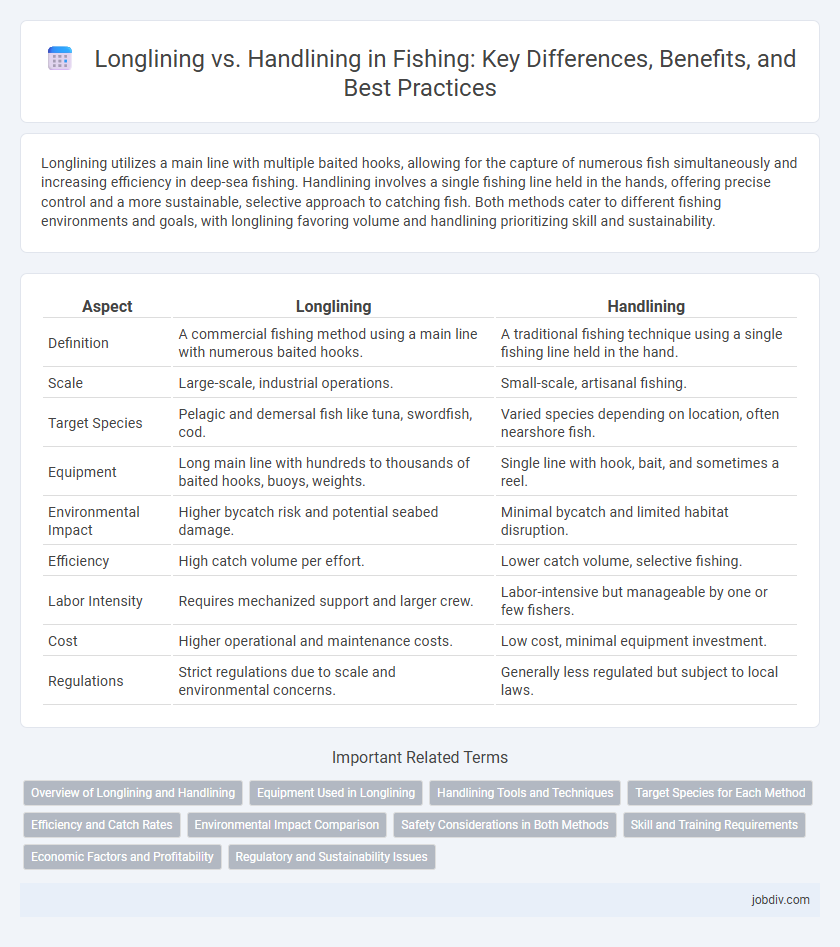Longlining utilizes a main line with multiple baited hooks, allowing for the capture of numerous fish simultaneously and increasing efficiency in deep-sea fishing. Handlining involves a single fishing line held in the hands, offering precise control and a more sustainable, selective approach to catching fish. Both methods cater to different fishing environments and goals, with longlining favoring volume and handlining prioritizing skill and sustainability.
Table of Comparison
| Aspect | Longlining | Handlining |
|---|---|---|
| Definition | A commercial fishing method using a main line with numerous baited hooks. | A traditional fishing technique using a single fishing line held in the hand. |
| Scale | Large-scale, industrial operations. | Small-scale, artisanal fishing. |
| Target Species | Pelagic and demersal fish like tuna, swordfish, cod. | Varied species depending on location, often nearshore fish. |
| Equipment | Long main line with hundreds to thousands of baited hooks, buoys, weights. | Single line with hook, bait, and sometimes a reel. |
| Environmental Impact | Higher bycatch risk and potential seabed damage. | Minimal bycatch and limited habitat disruption. |
| Efficiency | High catch volume per effort. | Lower catch volume, selective fishing. |
| Labor Intensity | Requires mechanized support and larger crew. | Labor-intensive but manageable by one or few fishers. |
| Cost | Higher operational and maintenance costs. | Low cost, minimal equipment investment. |
| Regulations | Strict regulations due to scale and environmental concerns. | Generally less regulated but subject to local laws. |
Overview of Longlining and Handlining
Longlining is a commercial fishing method involving a long main line with baited hooks spaced at intervals to target species like tuna and swordfish, enabling large-scale catch efficiency. Handlining, a traditional and manual technique, uses a single fishing line with a baited hook, prized for its precision and minimal environmental impact, often favored in small-scale and artisanal fisheries. Both methods vary significantly in scale, target species, and ecological footprint, influencing their application in sustainable fishing practices.
Equipment Used in Longlining
Longlining employs a main fishing line that can extend hundreds of meters, equipped with numerous baited hooks attached via branch lines called snoods, designed to target large pelagic species like tuna and swordfish. This method requires robust gear including heavy-duty reels, durable mainlines made from monofilament or braided materials, and circle hooks, ensuring strength and resistance to harsh ocean conditions. Compared to handlining, longlining's complex setup demands specialized equipment for deploying and retrieving extensive lines efficiently and safely.
Handlining Tools and Techniques
Handlining uses simple yet effective tools such as strong fishing lines, baited hooks, and handheld reels or wooden spools for line management. This technique relies on the angler's skill to feel the fish bite and manually pull the catch, offering precise control in targeting specific species. Compared to longlining, handlining reduces bycatch and environmental impact, making it a sustainable fishing method in coastal and small-scale fisheries.
Target Species for Each Method
Longlining targets large, pelagic species such as tuna, swordfish, and halibut by deploying extensive lines with multiple baited hooks designed for deep-water fishing. Handlining is more selective and effective for smaller, nearshore species like cod, snapper, and grouper, where fishermen use single lines with a single baited hook to maintain precise control. Each method's target species reflects differences in fishing scale, depth, and habitat preference, optimizing catch efficiency for distinct marine populations.
Efficiency and Catch Rates
Longlining offers higher catch rates by deploying extensive lines with numerous baited hooks, efficiently targeting multiple species over large areas. Handlining provides greater selectivity and reduces bycatch but is less efficient in volume and time compared to longlining. Fishermen aiming for maximum yield prioritize longlining, while handlining suits small-scale, sustainable catches.
Environmental Impact Comparison
Longlining poses a significant threat to marine biodiversity due to bycatch, capturing unintended species such as sea turtles, sharks, and seabirds, which disrupts ecological balance. Handlining presents a more sustainable alternative with minimal bycatch and reduced habitat damage since it targets specific species using selective, low-impact gear. Fisheries employing handlining contribute to healthier ocean ecosystems by lowering ghost gear pollution and preserving marine life diversity.
Safety Considerations in Both Methods
Longlining presents higher safety risks due to the use of extensive gear and potential entanglement hazards, requiring stringent handling protocols to prevent accidents. Handlining involves fewer gear-related dangers, but fishers face increased exposure to weather conditions and physical strain from manual line management. Effective safety measures in both methods include proper training, use of protective equipment, and adherence to operational guidelines to minimize injury and ensure crew wellbeing.
Skill and Training Requirements
Longlining demands advanced training due to its complexity in setting and retrieving extensive lines equipped with numerous baited hooks, requiring precise coordination and navigation skills. Handlining, by contrast, involves simpler techniques with a single line and hook, making it accessible to less experienced fishers but still requiring skill in timing and handling to effectively catch fish. Mastery in longlining typically results in higher yields and more targeted fishing, while handlining provides greater flexibility and immediacy for artisanal fishers.
Economic Factors and Profitability
Longlining generates higher revenue due to its large-scale operation and ability to target multiple species simultaneously, increasing catch volume and market value. Handlining, while less efficient, offers lower operational costs and minimal equipment investment, making it more accessible for small-scale fishers with limited capital. Profit margins depend on market demand, labor costs, and gear expenses, where longlining suits commercial ventures and handlining favors artisanal fisheries.
Regulatory and Sustainability Issues
Longlining faces stricter regulatory scrutiny due to its potential for high bycatch rates and ecosystem impacts, leading to limitations on gear types and fishing zones to ensure sustainability. Handlining is often regarded as more sustainable because it targets specific species with minimal bycatch and lower habitat disruption, resulting in fewer regulatory restrictions. Sustainable fisheries management increasingly favors handlining methods to promote biodiversity conservation and reduce overfishing pressures in vulnerable marine environments.
Longlining vs Handlining Infographic

 jobdiv.com
jobdiv.com